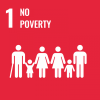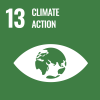Abene, 26 Oct 2021 – Walking on the beach in Abene, 65-year-old Boubacar Diatta has starkly contrasting memories as he avoids the stumps of mangrove trees uprooted and washed up by the rising sea level.
“I was born here, and we were among the first people to start fishing here. Back then the coastal line was further in from what you see today,” he says.
Abene, on the coastal end of southern Senegal in Casamance, was once well known for its fishing culture but that has changed, says Boubacar. The rise in sea level has pushed the community inland and structures that were next to the beach have been destroyed.

Boubacar Diatta, the President of the Abene Marine Protected Area in Abene has experienced the changes in the beach as a result of the rising waters. He and others are now looking at solutions to the coastal and marine degradation. Photo: IOM/Kennedy Okoth
"Back then we would dock our boats by the beach after our fishing expedition, but as you can see now, there isn’t much beach left and most fishermen have been forced to dock in the waters," Boubacar says.
The rise of sea levels has also increased pollution as garbage floats off the land. Fish have retreated to deeper waters, forcing fishermen to go out for longer hours for the daily catch. For some, it is too hard and they have resorted to either internal migration to other parts of Senegal or worse, dangerous irregular migration for an alternative livelihood.
“There are fishermen that I know who have left. There are others who have returned, and others were not fortunate enough and died on the way,” Boubacar says. “There are fishing boats that require four or five crew but are run by three because many people have left."
Irregular migration is discussed in low tones, but the subject is known by everyone in Abene. Some of the boats previously used for fishing have been modified and used on the dangerous route to Europe. Some of those remaining, including 35-year-old Keba Sonko, have attempted to hold back the rising waters and stop pollution by creating barricades with sandbags but it has been a futile exercise.
“It happens quite quickly. We tried to do as much as possible to hold back the erosion by making small dams," Keba says. "The water has won, and the sand has lost ground, and, in the process, we have lost a large amount of the beach.”

The beach in Kafountine is known for its fishing; however, like many others, the number of fish are decreasing as the sea level rises. Photo: IOM/Kennedy Okoth
With fishing already threatened, the alternative to the community in Abene and many other villages along the coastal line of southern Senegal would be agriculture – specifically rice production – but that, too, is under threat from increased soil salinity as the sea rises. It is the same in Kafountine, a neighbouring coastal village, where women engage mostly in buying and selling fish after processing.

Part of the beach in Kafountine where the rising sea level has started to engulf some of the structures along the coastal lines. Photo: IOM/Kennedy Okoth
Nyota Fatou, who leads the women's group at the beach, says their businesses have been affected.
“We used to grow a lot of rice here, but now the rice fields are spoiled because of the salt. The processing station was along the beach. We had to move because the water was rising to where we were, and the rice fields were not productive anymore.”

Nyota Fatou leads a group of women who engage in fish processing and resale. They have had to be pushed away from the beachside as the waters continue to rise. Photo: IOM/Kenney Okoth
The adverse effects of climate change threaten livelihoods all along the coastal line and increasingly inland in Southern Senegal. Distressingly, dangerous irregular migration channels are all too often considered worth the risk to lives.
The International Organization for Migration (IOM), together with partners and the Government, is looking at community-based approaches to improve livelihoods and identify coastal and marine resilience projects aimed at reducing coastal erosion and loss of coastal habitat.
Boubacar, Keba, and Nyota are part of a dialogue involving returning migrants, including women and youth from households affected by migration, to find possible solutions to coastal and marine degradation such as the deforestation of mangrove forests and salinization of agricultural lands.
Following the dialogue, several projects will be implemented with these goals through cash-for-work with Community Village Saving and Loans Associations (VSLA) created to ensure sustainability and help mitigate the economic instability that leads to migration.
Boubacar oversees the beach as the President of Abene Marine Protected Area, a role he has taken up for the last decade to try and preserve the beach and prevent further degradation and loss of fish. He welcomes the environmental and climate action as crucial if Abene is to be restored to its earlier glory days.
These efforts are part of the IOM-led project on "Implementing Global Policies on Environmental Migration and Disaster Displacement in West Africa" funded by the Government of France.
Help IOM continue to provide assistance to migrants, refugees and host communities for a sustainable future, and increase their resilience to future disasters.


